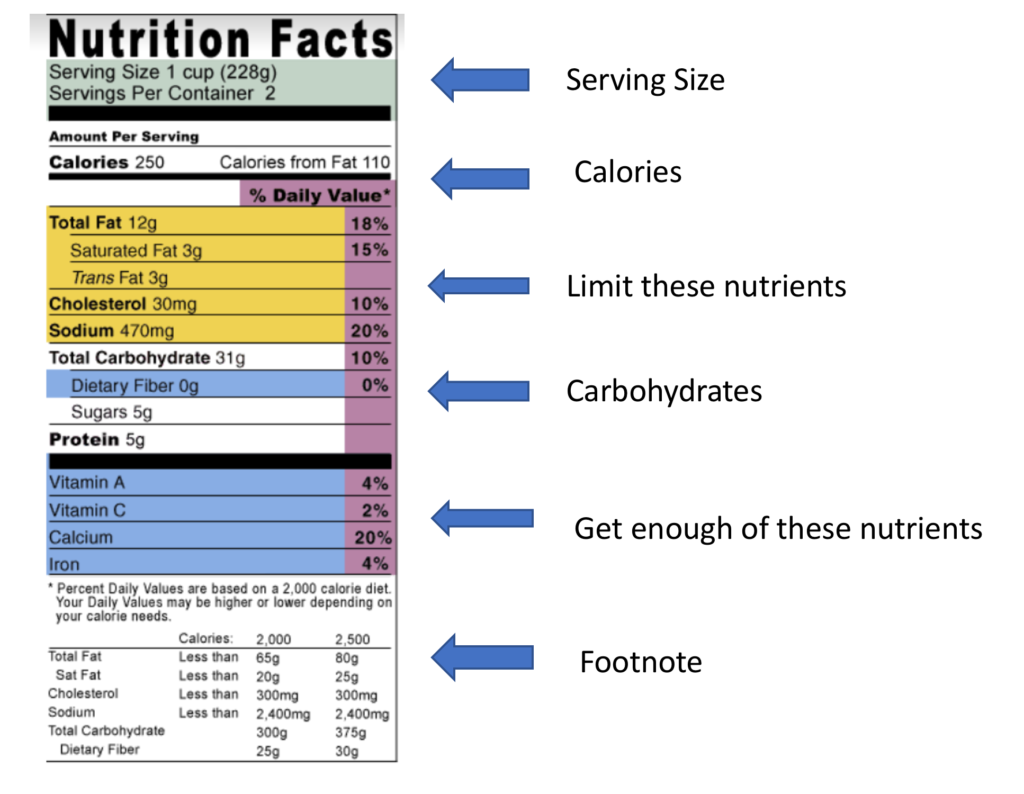Nutrition Facts Label
go.ncsu.edu/readext?726172
en Español / em Português
El inglés es el idioma de control de esta página. En la medida en que haya algún conflicto entre la traducción al inglés y la traducción, el inglés prevalece.
Al hacer clic en el enlace de traducción se activa un servicio de traducción gratuito para convertir la página al español. Al igual que con cualquier traducción por Internet, la conversión no es sensible al contexto y puede que no traduzca el texto en su significado original. NC State Extension no garantiza la exactitud del texto traducido. Por favor, tenga en cuenta que algunas aplicaciones y/o servicios pueden no funcionar como se espera cuando se traducen.
Português
Inglês é o idioma de controle desta página. Na medida que haja algum conflito entre o texto original em Inglês e a tradução, o Inglês prevalece.
Ao clicar no link de tradução, um serviço gratuito de tradução será ativado para converter a página para o Português. Como em qualquer tradução pela internet, a conversão não é sensivel ao contexto e pode não ocorrer a tradução para o significado orginal. O serviço de Extensão da Carolina do Norte (NC State Extension) não garante a exatidão do texto traduzido. Por favor, observe que algumas funções ou serviços podem não funcionar como esperado após a tradução.
English
English is the controlling language of this page. To the extent there is any conflict between the English text and the translation, English controls.
Clicking on the translation link activates a free translation service to convert the page to Spanish. As with any Internet translation, the conversion is not context-sensitive and may not translate the text to its original meaning. NC State Extension does not guarantee the accuracy of the translated text. Please note that some applications and/or services may not function as expected when translated.
Collapse ▲Nutrition labels are a great tool to help us learn about the food we eat and be mindful of our food choices. Learning how to read the Nutrition Facts label is a valuable skill that will help you choose healthy foods.
Note: Color is used on this label for teaching purposes, the Nutrition Facts label is not color coded.
Serving Size
The label helps us determine how many servings are in the container. The serving sizes used on the food label are standardized to help us compare similar foods to each other. For example, dry cereal is listed in cups, serving size for crackers is listed as number of crackers. Serving per container is especially helpful when looking at what appear to be “single-serving containers.” Often what is sold as a single serving is actually 2 or more servings. For example, a 16-ounce beverage may seem like a single serving, but if you read the label carefully, you will see it contains 2 servings.
Calories
The Nutrition Facts label tells us how many calories are in each serving. Remember that this is for one serving of the food or beverage. Using the Nutrition Facts label image above, if we ate 1-½ cups of this food, we would get 250+125 calories for a total of 375 calories. Pay close attention to serving sizes as they are critical to managing calories and body weight.
Limit these nutrients
Listed first on the label are the nutrients that Americans typically eat in adequate amounts, or even too much, they are listed in yellow. Eating too much fat, saturated fat, trans fat, cholesterol or sodium may increase your risk of certain chronic diseases, like heart disease, some cancers or high blood pressure.
Carbohydrates
Total Carbohydrates include dietary fiber and sugar. Look for foods with higher amounts of dietary fiber and lower amounts of sugar.
Get enough of these nutrients
Americans need to make sure they get adequate dietary fiber, vitamin A, vitamin C, calcium and iron in their diets. These nutrients are identified in blue. Eating enough of these nutrients can improve your health and help reduce the risk of some diseases.
% Daily Value
The % Daily Values (%DVs) are based on the Daily Value recommendations for key nutrients for a 2,000 calories daily diet. The %DV helps you determine if a serving of food is high or low in a nutrient. If the Daily Value is 5% or less, then the food is low in that nutrient. If the value is 20% or more, then the food is a good source of that nutrient. For example, the Daily Value for calcium is 20% so this food is a good source of calcium. If you ate 2 servings of this food you would get 40% of your daily needs for calcium. Note: Not all nutrients will have a Daily Value.
Footnote
At the bottom of the Nutrition Facts is a footnote that serves as a guide. This footnote shows recommendations for a 2,000 calorie diet and a 2,500 calorie diet. This footnote will always be the same. The footnote doesn’t change from product to product. It shows recommended dietary advice for all Americans and is not about a specific food product. The USDA’s MyPlate website provides information and tools about choosing healthy foods and recipes to meet their dietary needs. Check out this website, and the tab labeled “Online Tools” for more information: MyPlate
For questions regarding the Nutrition Facts label, please reach out to Patti Snyder at (336) 593-8179 or by email at patti_snyder@ncsu.edu





